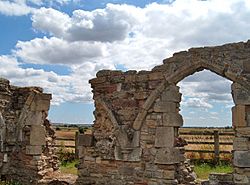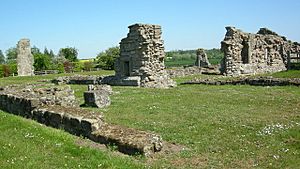Mattersey Priory facts for kids

The Ruins of Mattersey Priory
|
|
| Monastery information | |
|---|---|
| Order | Gilbertine |
| Established | c.1185 |
| Disestablished | 1538 |
| Dedicated to | St Helen |
| People | |
| Founder(s) | Roger FitzRalph |
| Site | |
| Location | Mattersey, Nottinghamshire |
| Coordinates | 53°23′53″N 0°56′37″W / 53.398193°N 0.94369°W |
| Visible remains | Ruins |
| Public access | Yes Currently managed by English Heritage and open free of charge. |
Mattersey Priory was once a special kind of monastery called a Gilbertine priory. It's found close to the village of Mattersey in Nottinghamshire, England. Today, English Heritage looks after these old ruins, and you can even visit them for free!
Contents
The Priory's Story
How Mattersey Priory Began
Mattersey Priory was started around the year 1185 by a person named Roger FitzRalph. It was built to honor Saint Helen. The priory was special because it was built on a small island made of gravel in the River Idle. Back then, the land around it was mostly wet marshland.
The priory was meant to be home to six canons. Canons were male members of the Gilbertine order, a religious group. Sometimes, up to ten canons could live there. Unlike some other Gilbertine places, Mattersey was only for men; women (called canonesses) did not live here.
Challenges and Changes
In 1279, a fire sadly destroyed the priory's church. It was never rebuilt after that. The priory was also known for not being very rich. In 1291, its income was about £52, which was not a lot for a monastery.
In 1403, King Henry IV gave the priory special permission. They could hold a market every Monday in Mattersey. The King also allowed them to have two yearly fairs. These fairs happened on Saint John of Beverley's day (May 7) and Saint Simon and Saint Jude's day (October 28).
The Priory's End
Mattersey Priory was closed down as part of King Henry VIII's Dissolution of the Monasteries. This was when many monasteries in England were shut down by the King. The priory was officially closed on October 3, 1538.
The people who lived there, including the Prior (the head of the priory) Thomas Norman, and three canons, left the priory. The next year, they were given yearly payments to help them.
In 1539, the priory and its land were given to a person named Anthony Nevill. Later, around 1605, Mrs. Margaret Nevill wrote a letter inviting someone to visit the "poor old Abbey of Mattersley."
Mattersey Priory Today
In 1912, the site was taken care of by the "Commissioners of Works." Now, English Heritage manages the ruins, keeping them safe for everyone to visit and learn from.
Leaders of Mattersey Priory
Here are some of the known Priors (leaders) of Mattersey Priory:
- Walter, around 1247
- John, around 1303
- Thomas Norman, around 1538 (the last Prior)
Exploring the Priory's Buildings
What the Priory Looked Like
The priory church was a short, narrow building without side aisles or extra wings. A tower was built on the north side of the church in the 15th century.
To the south of the church were the cloisters. These were covered walkways around a central courtyard. Buildings stood on three sides of this courtyard.
- The eastern building was built after the fire in 1279. On the ground floor, it had a large room that was divided into a chapel, a chapter house (where meetings were held), and a warming room. Above this was the "dorter," which was the sleeping area. At the end of the sleeping area was the "reredorter," a communal toilet.
- The southern building was a bit larger than the eastern one. It also had two floors. The ground floor was a storage area, and the upper floor was the "frater" or refectory. This was the dining hall where the canons ate their meals.
- The western building was first used for lay-brothers (people who helped with the priory's work). It had a dining hall on the ground floor and sleeping quarters above. Later, it's thought this building became the home for the Prior.
- To the southwest, there was a square building that held the monastic kitchens.
What Remains Today
The ruins of Mattersey Priory are next to the River Idle, just east of the village of Mattersey. What you can see today are mainly the foundations of the old buildings.
You can still see parts of the 12th-century priory church. There are also three arches from the canons' dining hall. You can find the foundations of the 14th-century monastic kitchens and parts of the 15th-century tower. The foundations of other service buildings, like barns and a bakehouse, are thought to be under the nearby Abbey Farm.
In 1914, some digging helped find the buried foundations of the eastern and southern cloister buildings. A small amount of repair work was also done during these digs.



